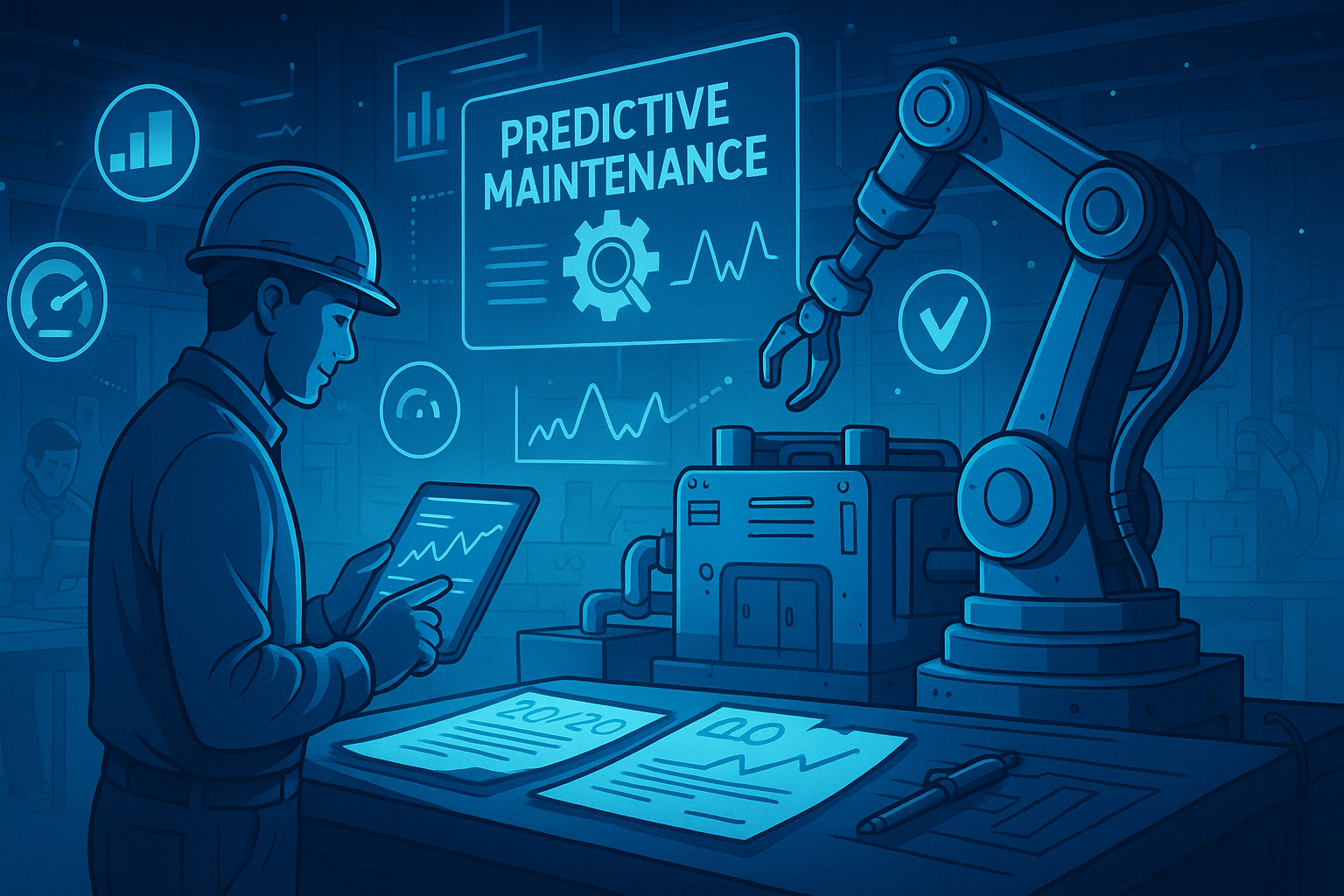Industry 4.0’s New Frontier of Maintenance
Industry 4.0 has become the defining label for the digital transformation of factories and supply chains. It brings together sensors, cloud computing, artificial intelligence, and automation into an interconnected system that promises to change how industries operate. Within this ecosystem, predictive maintenance has emerged as one of the most celebrated innovations. It claims to anticipate machine failures before they occur, cut unnecessary downtime, and extend the lifespan of assets.
The excitement is understandable. Leaders, marketers, and researchers see predictive maintenance as a way to protect revenue streams, build resilience, and demonstrate forward thinking in highly competitive markets. At the same time, technology raises questions that go beyond engineering or finance. If machines and processes are monitored at all times, what happens to the workers who operate them? If every action leaves a digital trace, does efficiency come at the expense of trust and autonomy?
The debate is no longer about whether predictive maintenance works. The real challenge is deciding what kind of industrial culture it creates.
How Predictive Maintenance Works and Why It Excites Industry Leaders

Predictive maintenance sits at the heart of Industry 4.0 because it embodies the logic of using data as a strategic asset. Instead of waiting for equipment to fail, companies now install sensors that track vibration, temperature, pressure, and energy consumption. These streams of data flow into advanced analytics platforms, where algorithms detect patterns and forecast when a machine might break down. The goal is to act at the right moment, avoiding costly interruptions while minimizing unnecessary repairs.
For executives, the appeal is straightforward. Downtime is one of the most expensive problems in manufacturing, and even a few hours of halted production can translate into millions in lost revenue. Predictive maintenance promises foresight, giving leaders the ability to schedule interventions with surgical precision. Marketers also see an opportunity to brand companies as technologically advanced, aligning their operations with the broader narrative of Industry 4.0 innovation.
Market researchers highlight another attraction. The data collected through predictive maintenance does not only serve maintenance teams. It also feeds into product development, supply chain planning, and even customer service strategies. Leaders are drawn to the idea of a feedback loop that turns equipment into a source of continuous insight, reinforcing competitiveness in a rapidly digitizing economy.
The Business Case: Efficiency, Cost Savings, and Competitive Advantage

For many executives, predictive maintenance is less a technical upgrade and more a financial strategy. The numbers tell a persuasive story. Studies frequently report that predictive maintenance can cut maintenance costs by double-digit percentages, reduce unplanned outages, and extend equipment life by years. These outcomes translate directly into stronger balance sheets, which is why business leaders often present technology as an investment rather than an expense.
The efficiency narrative goes beyond accounting. When machines are monitored intelligently, production schedules can be maintained with greater reliability. Customers notice when orders arrive on time, when delays shrink, and when quality remains consistent. This builds trust and strengthens commercial relationships. In highly competitive industries, the ability to guarantee delivery can be as valuable as the products themselves.
Marketers and strategists also highlight the reputational value. A company that implements predictive maintenance signals innovation and adaptability, traits that appeal to investors and partners. Industry 4.0 is not only about smarter factories but also about positioning a brand as part of the future. The ability to show cost savings while claiming leadership in digital transformation offers a dual advantage that explains why so many firms are eager to adopt predictive maintenance on a scale.
The Hidden Risks: Surveillance, Worker Autonomy, and Data Ethics

The success of predictive maintenance depends on constant monitoring. Sensors and analytics do not discriminate between machines and the humans who operate them. Once every movement, adjustment, and deviation is recorded, the line between equipment management and worker surveillance begins to blur. For many employees, the promise of efficiency is accompanied by the feeling of being watched in ways that were never possible in earlier industrial eras.
This raises ethical questions that extend beyond technical performance. If data collection expands without clear boundaries, organizations risk undermining trust among their workforces. Workers may perceive the technology less as a tool for safety and productivity and more as a system designed to measure, evaluate, and ultimately control them. The very data that prevents machine failures can also be used to evaluate human behavior, often without transparency about who has access or how the information will be used.
Market leaders are beginning to recognize that these concerns are not secondary. A company that mishandles worker trust can face reputational damage, higher turnover, and labor disputes. Efficiency gains are quickly overshadowed if the workforce views predictive maintenance as an intrusive form of oversight rather than a shared advancement in industrial practice.
The Debate: Balancing Innovation with Responsibility in Industry 4.0
Predictive maintenance embodies the tension at the core of Industry 4.0. On one side, it is a symbol of progress that promises efficiency, cost savings, and sharper competitiveness. On the other hand, it introduces new dynamics of surveillance and data control that reshape the relationship between employers and employees. This duality sparks a debate that executives, policymakers, and researchers cannot afford to ignore.
Some view predictive maintenance as a breakthrough that validates the digital transformation narrative. They argue that constant monitoring is simply the price of modern efficiency and that the benefits outweigh the risks. Others caution that adopting technology without considering its cultural and ethical consequences can lead to unintended damage, particularly in how workers experience their roles and responsibilities.
The real challenge lies in defining the rules of engagement. Predictive maintenance does not operate in isolation. It is connected to broader issues of data ownership, algorithmic transparency, and the distribution of power in digital workplaces. The decision to implement it is not only a technical or financial calculation but also a statement about how an organization envisions its future. Innovation without responsibility risks becoming a form of overreach disguised as progress.
Building a Future Where Efficiency and Ethics Coexist

Predictive maintenance has become one of the most visible promises of Industry 4.0. It offers clear economic value, stronger competitiveness, and a vision of industrial operations that are less wasteful and more resilient. At the same time, its reliance on constant monitoring challenges traditional boundaries of privacy, trust, and workplace culture. Technology is neither a pure cost saving nor a simple surveillance mechanism. It is a double-edged tool that reflects the priorities and governance choices of those who implement it.
The future of predictive maintenance will depend on whether organizations approach it as a technical fix or as part of a broader social contract. Companies that combine efficiency with transparency and ethical responsibility will find the technology strengthens both performance and legitimacy. Those that ignore these concerns risk turning progress into a source of resistance.
What does Industry 4.0 mean?
It’s the digital transformation of manufacturing—connecting machines, processes, and data for smarter operations.
How does H-in-Q support Industry 4.0?
We build AI models that predict demand, optimize supply chains, monitor machine performance, and improve quality control.
What kind of data is used?
IoT sensors, machine logs, production flows, and ERP data are mined for predictive insights.
What solutions are available?
Predictive maintenance, demand forecasting, process optimization, and anomaly detection dashboards.
Why is AI critical in Industry 4.0?
Because efficiency gains depend on real-time analytics, automated decision-making, and seamless digital workflows.
Can SMEs adopt Industry 4.0 solutions?
Yes. Our modular AI stack makes it cost-effective and scalable for smaller manufacturers too
Ressources :
- Medium article on predictive maintenance applications and advantages
- IOT Analytics piece on top companies enabling predictive maintenance
- Manufacturing Digital’s overview of predictive maintenance platforms
- AIMultiple research on AI use cases in manufacturing, including predictive maintenance
- WorkTrek blog on best predictive maintenance tools
- https://h-in-q.com/analytics/



